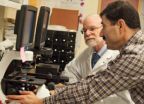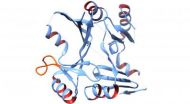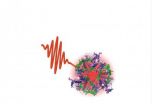(Press-News.org) Emergence of new microbes
While many endemic infectious diseases of humans have been largely contained, new microbes continue to emerge to threaten human and animal health. Such emerging infectious diseases are not confined to humans and their livestock but extend to wildlife ecosystems; the finely-tuned dynamic balance of which is destabilised by human interventions. The changes in the scale and manner of livestock production and marketing, the increase of global travel and trade including the trade in domestic livestock as well as the pet animal trade, the increasing encroachment into stable ecosystems and ecological changes, all contribute to novel disease emergence. Over two-third of novel emerging pathogens are zoonotic in origin. Because of their higher intrinsic mutation rates and adaptability in crossing species barriers, RNA viruses are the cause of many of these novel emerging infections.
Economic Impacts
In addition to their impacts on human health, such novel emerging pathogens often have huge economic, social, and sometimes political consequences. Recent examples are the Severe Acute Respiratory Syndrome, SARS (estimated global economic impact was US$42 billion), the Middle East Respiratory Syndrome, MERS, the H1N1 pandemic of 2009, the highly pathogenic avian influenza H5N1 (global impact US$20 billion up to 2009), the avian influenza H7N9, the Nipah virus and (though not a virus) the Bovine Spongiform Encephalopathy, BSE (US$16 billion within UK alone).
Detection, Response and Prevention
While many of these have arisen in Asia, such outbreaks may arise anywhere (e.g. BSE in UK, pandemic H1N1 2009 in North America). Early detection and response is crucial for effective disease containment or mitigation. Bio-surveillance for unusual disease events (unusual disease patterns or clusters of cases) is important to target diagnostic efforts. Networks such as GOARN and Promed have provided yeomen service in this regard, but other options for the "collection and synergistic analysis of data from many sources and the dissemination of actionable information followed by timely decision-making" is the focus of this symposium. Molecular diagnostics, and more recently, Next Gen "deep-sequencing", provide greatly enhanced speed and capability for the detection of novel pathogens. However, it is crucial that "classical" microbiological techniques and expertise are not lost. For example, the traditional methods of virus culture, electron microscopy and detection of serologic responses were crucial in the detection and confirmation of the etiology of SARS1.
Rapid and early assessment of the transmission dynamics and disease severity is important for policy making and calibrated responses; the global response to the 2009 H1N1 pandemic being a case in point2. Identification of the proximate sources of zoonotic infection provides actionable interventions to reduce risk1,3. For example, research on the transmission dynamics of avian influenza viruses within the live poultry marketing chain in Hong Kong provides evidence-based options for control of zoonotic disease caused by H5N1 and H7N9 avian influenza viruses4,5. Similarly, it is critically important to identify the source of zoonotic MERS coronavirus infection so relevant interventions may be applied to minimise such infection. Surveillance to better define the microbial diversity in domestic livestock and wild-life and research to better understand the ecological, virological and host determinants of inter-species transmission will allow better risk assessment of zoonotic events3,6,7.
Conclusion
As many emerging virus infections arise from animal reservoirs, a "One Health" approach is essential to their containment so that human health benefits are optimized while maintaining food security, safeguarding the economics of animal husbandry, preserving the environment and remaining sensitive to cultural practices4. Such "upstream interventions" may provide options to contain novel emerging infections "at source".
INFORMATION:
Relevant references from HKU
Research group
1. Peiris JS, Guan Y. Confronting SARS: a view from Hong Kong. Philos Trans R Soc Lond B Biol Sci. 2004 Jul 29;359(1447):1075-9.
2. Wu JT, et al. Estimating infection attack rates and severity in real time during an influenza pandemic: analysis of serial cross-sectional serologic surveillance data. PLoS Med. 2011 Oct;8(10):e1001103.
3. Chan JF, et al. Interspecies transmission and emergence of novel viruses: lessons from bats and birds. Trends Microbiol. 2013 Oct;21(10):544-55.
4. Sims L.D., Peiris M. (2013). One health: the Hong Kong experience with avian influenza. In One Health: The human-animal – environment interfaces in Emerging Infectious Diseases (J.S MacKenzie, M. Jeggo, P. Daszak & J.A. Richt, eds).. Curr Top Microbiol Immunol., 365, 281-298.
5. Yu H, Wu JT, Cowling BJ, Liao Q, Fang VJ, Zhou S, Wu P, Zhou H, Lau EH, Guo D, Ni MY, Peng Z, Feng L, Jiang H, Luo H, Li Q, Feng Z, Wang Y, Yang W, Leung GM. Effect of closure of live poultry markets on poultry-to-person transmission of avian influenza A H7N9 virus: an ecological study. Lancet. 2013 Oct 30. pii:S0140-6736(13)61904-2.
6. Vijaykrishna D, et al Long-term evolution and transmission dynamics of swine influenza A virus. Nature. 2011 May 26;473(7348):519-22.
7. Yen HL, et al. Hemagglutinin-neuraminidase balance confers respiratory-droplet transmissibility of the pandemic H1N1 influenza virus in ferrets. Proc Natl Acad Sci U S A. 2011 Aug 23;108(34):14264-9.
Zoonotic diseases and global viral pandemics
By Malik Peiris, the University of Hong Kong
2014-02-17
ELSE PRESS RELEASES FROM THIS DATE:
JCI early table of contents for Feb. 17, 2014
2014-02-17
Neurotensin conjugate provides pain relief in animal models
The small peptide neurotensin is a potent regulator of dopamine signaling and can provide dramatic pain relief; however, the blood brain barrier provides a substantial challenge toward clinical use of neurotensin for analgesia. In this issue of the Journal of Clinical Investigation, Philippe Sarret and colleagues at Université de Sherbrooke generated a conjugate of neurotensin with a peptide able to cross the blood brain barrier and evaluated the analgesic effects of this molecule in animal models of pain. The ...
Extensive renewal of the T cell repertoire following autologous stem cell transplant in MS
2014-02-17
WA, Seattle (February 17, 2014) – A new study describes the complexity of the new T cell repertoire following immune-depleting therapy to treat multiple sclerosis, improving our understanding of immune tolerance and clinical outcomes.
In the Immune Tolerance Network's (ITN) HALT-MS study, 24 patients with relapsing, remitting multiple sclerosis received high-dose immunosuppression followed by a transplant of their own stem cells, called an autologous stem cell transplant, to potentially reprogram the immune system so that it stops attacking the brain and spinal cord. ...
Finding common ground fosters understanding of climate change
2014-02-17
EAST LANSING, Mich. — Grasping the concept of climate change and its impact on the environment can be difficult. Establishing common ground and using models, however, can break down barriers and present the concept in an easily understood manner.
In a presentation at this year's meeting of the American Association for the Advancement of Science, Michigan State University systems ecologist and modeler Laura Schmitt-Olabisi shows how system dynamics models effectively communicate the challenges and implications of climate change.
"In order to face the ongoing challenges ...
Small non-coding RNAs could be warning signs of cancer
2014-02-17
Small non-coding RNAs can be used to predict if individuals have breast cancer conclude researchers who contribute to The Cancer Genome Atlas project. The results, which are published in EMBO reports, indicate that differences in the levels of specific types of non-coding RNAs can be used to distinguish between cancerous and non-cancerous tissues. These RNAs can also be used to classify cancer patients into subgroups of individuals that have different survival outcomes.
Small non-coding RNAs are RNA molecules that do not give rise to proteins but which may have other ...
New finding points to potential options for attacking stem cells in triple-negative breast cancer
2014-02-17
ANN ARBOR, Mich. — New research from the University of Michigan Comprehensive Cancer Center and Georgia Regents University finds that a protein that fuels an inflammatory pathway does not turn off in breast cancer, resulting in an increase in cancer stem cells. This provides a potential target for treating triple negative breast cancer, the most aggressive form of the disease.
The researchers identified a protein, SOCS3, that is highly expressed in normal cells but undetectable in triple-negative breast cancer. They showed that this protein is degraded in cancers, blocking ...
Religious and scientific communities may be less combative than commonly portrayed
2014-02-17
One of the largest surveys of American views on religion and science suggests that the religious and scientific communities may be less combative than is commonly portrayed in the media and in politics.
Only 27 percent of those surveyed said that they viewed science and religion as being in conflict with each other, with about equal percentages of those people "siding with either religion or science," said Rice University sociologist Elaine Howard Ecklund at the AAAS Annual Meeting. The survey was commissioned by the AAAS Dialogue on Science, Ethics and Religion (DoSER) ...
Uncovering the secrets of tularemia, the 'rabbit fever'
2014-02-17
WASHINGTON D.C. Feb. 16, 2014 -- Tularemia, aka "rabbit fever," is endemic in the northeastern United States, and is considered to be a significant risk to biosecurity -- much like anthrax or smallpox -- because it has already been weaponized in various regions of the world.
At the 58th Annual Biophysical Society Meeting, which takes place Feb. 15-19, 2014, in San Francisco, Calif., Geoffrey K. Feld, a Postdoctoral researcher in the Physical & Life Sciences Directorate at Lawrence Livermore National Laboratory (LLNL), will describe his work to uncover the secrets of the ...
Bacterial superbug protein structure solved
2014-02-17
WASHINGTON D.C. Feb. 16, 2014 -- A research team from Vanderbilt University Medical Center in Nashville, Tenn., is the first to decipher the 3-D structure of a protein that confers antibiotic resistance from one of the most worrisome disease agents: a strain of bacteria called methicillin-resistant Staphylococcus aureus (MRSA), which can cause skin and other infections. The Vanderbilt team's findings may be an important step in combatting the MRSA public health threat over the next 5 to 10 years.
By deciphering the shape of a key S. aureus protein -- an enzyme called ...
Harvesting light, the single-molecule way
2014-02-17
WASHINGTON D.C. Feb. 16, 2014 -- New insights into one of the molecular mechanisms behind light harvesting, the process that enables photosynthetic organisms to thrive, even as weather conditions change from full sunlight to deep cloud cover, will be presented at the 58th Annual Biophysical Society Meeting, taking place in San Francisco from Feb. 15-19.
At the meeting, Hsiang-Yu Yang, a graduate student, and Gabriela Schlau-Cohen, a postdoc in W.E. Moerner's research group at Stanford University, will describe how probing these natural systems at the single molecule level ...
Deep ocean needs policy, stewardship where it never existed
2014-02-17
BEAUFORT, N.C. -- Technological advances have made the extraction of deep sea mineral and precious metal deposits feasible, and the dwindling supply of land-based materials creates compelling economic incentives for deep sea industrialization. But at what cost?
“We’re really in the dark when it comes to the ecology of the deep sea," said Linwood Pendleton, director of the Ocean and Coastal Policy Program at the Nicholas Institute for Environmental Policy Solutions at Duke University. "We know a lot about a few places, but nobody is dealing with the deep sea as a whole, ...
LAST 30 PRESS RELEASES:
Making lighter work of calculating fluid and heat flow
Normalizing blood sugar can halve heart attack risk
Lowering blood sugar cuts heart attack risk in people with prediabetes
Study links genetic variants to risk of blinding eye disease in premature infants
Non-opioid ‘pain sponge’ therapy halts cartilage degeneration and relieves chronic pain
AI can pick up cultural values by mimicking how kids learn
China’s ecological redlines offer fast track to 30 x 30 global conservation goal
Invisible indoor threats: emerging household contaminants and their growing risks to human health
Adding antibody treatment to chemo boosts outcomes for children with rare cancer
Germline pathogenic variants among women without a history of breast cancer
Tanning beds triple melanoma risk, potentially causing broad DNA damage
Unique bond identified as key to viral infection speed
Indoor tanning makes youthful skin much older on a genetic level
Mouse model sheds new light on the causes and potential solutions to human GI problems linked to muscular dystrophy
The Journal of Nuclear Medicine ahead-of-print tip sheet: December 12, 2025
Smarter tools for peering into the microscopic world
Applications open for funding to conduct research in the Kinsey Institute archives
Global measure underestimates the severity of food insecurity
Child survivors of critical illness are missing out on timely follow up care
Risk-based vs annual breast cancer screening / the WISDOM randomized clinical trial
University of Toronto launches Electric Vehicle Innovation Ontario to accelerate advanced EV technologies and build Canada’s innovation advantage
Early relapse predicts poor outcomes in aggressive blood cancer
American College of Lifestyle Medicine applauds two CMS models aligned with lifestyle medicine practice and reimbursement
Clinical trial finds cannabis use not a barrier to quitting nicotine vaping
Supplemental nutrition assistance program policies and food insecurity
Switching immune cells to “night mode” could limit damage after a heart attack, study suggests
URI-based Global RIghts Project report spotlights continued troubling trends in worldwide inhumane treatment
Neutrophils are less aggressive at night, explaining why nighttime heart attacks cause less damage than daytime events
Menopausal hormone therapy may not pose breast cancer risk for women with BRCA mutations
Mobile health tool may improve quality of life for adolescent and young adult breast cancer survivors
[Press-News.org] Zoonotic diseases and global viral pandemicsBy Malik Peiris, the University of Hong Kong



